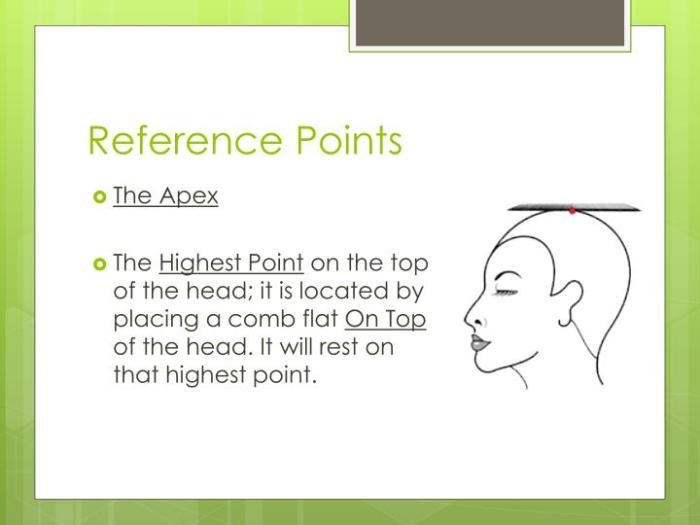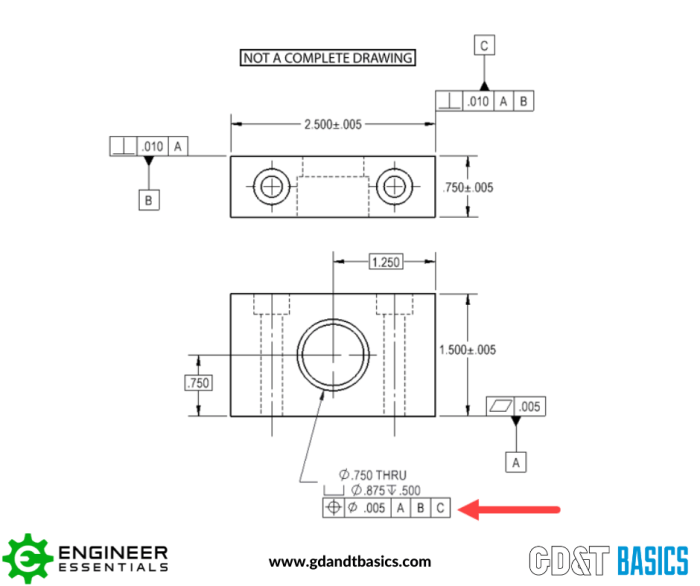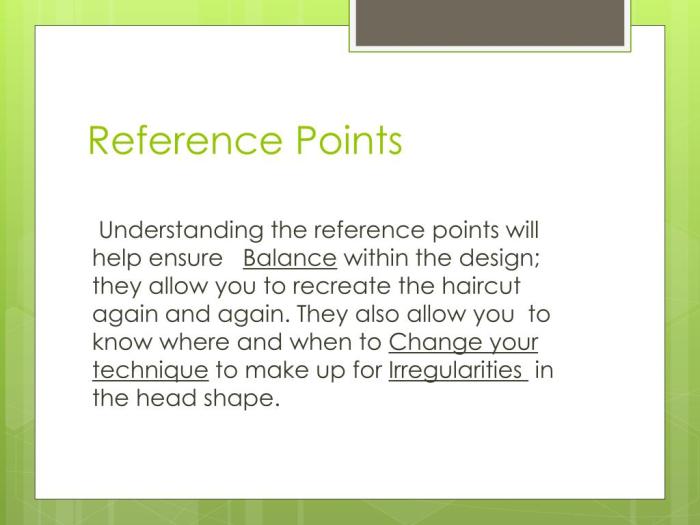Reference points in a haircut are used to establish – In the realm of hair artistry, reference points serve as indispensable guides, shaping the precision and accuracy of every haircut. These carefully established markers provide a structured framework upon which stylists meticulously craft their creations, ensuring that each strand falls into its intended place.
Reference points not only enhance the technical proficiency of haircuts but also contribute to their aesthetic appeal. By adhering to these guidelines, stylists can create harmonious proportions and balance, resulting in haircuts that flatter the individual’s facial features and hair texture.
Reference Points in Haircuts: Reference Points In A Haircut Are Used To Establish

Reference points are crucial landmarks on the head that guide hairstylists in creating precise and accurate haircuts. These points establish a framework for the haircut and ensure consistency throughout the cutting process.
Types of Reference Points
- Central Vertical Parting:Divides the head into equal left and right halves.
- Horizontal Partings:Parallel lines drawn around the head to create layers.
- Natural Crown:The highest point on the head, often used as a starting point for cutting.
- Side Points:Located on the temples, they determine the length of the sides.
- Nape Point:The lowest point on the back of the head, used to create necklines.
Techniques for Establishing Reference Points
Establishing reference points requires precision and attention to detail:
- Sectioning:Divide the hair into sections to create clear partings.
- Combing:Use a comb to create clean and straight partings.
- Measuring:Use a ruler or measuring tape to determine the desired lengths.
- Marking:Use clips or temporary markers to indicate the reference points.
Use of Reference Points in Haircutting, Reference points in a haircut are used to establish
Reference points serve as a roadmap for hairstylists:
- Length Determination:They establish the desired length of the hair at different points on the head.
- Shape Creation:Reference points guide the cutting angles and techniques used to create the desired shape.
- Precision and Accuracy:They ensure that the haircut is executed with precision and consistency.
Reference Points for Different Hair Textures and Types
Reference points may vary depending on the hair texture and type:
- Fine Hair:Requires closer reference points due to its delicate nature.
- Thick Hair:May require wider reference points to accommodate its density.
- Curly Hair:Reference points should be adjusted to account for the hair’s natural curl pattern.
Reference Points for Specific Haircuts
Reference points play a vital role in creating specific haircuts:
- Bobs:Horizontal reference points determine the length and angle of the cut.
- Layers:Reference points create the desired depth and movement.
- Fades:Reference points establish the transition points between different lengths.
Advanced Techniques and Considerations
Advanced techniques include:
- Overlapping Reference Points:Creating multiple reference points for greater precision.
- Dynamic Reference Points:Adjusting reference points based on the individual’s head shape and hair growth patterns.
Considerations for using reference points include:
- Hairline:The natural hairline should be considered when establishing reference points.
- Hair Growth Patterns:Reference points should accommodate the direction of hair growth.
- Symmetry:Reference points should be established symmetrically to ensure a balanced haircut.
Questions and Answers
What is the purpose of reference points in haircuts?
Reference points provide a structured framework for stylists to follow, ensuring precision, accuracy, and balance in their haircuts.
How are reference points established?
Reference points are established using various techniques, including measurements, anatomical landmarks, and visual cues.
What are the different types of reference points used in haircuts?
Common reference points include the crown, nape, ears, temples, and occipital bone.


